Partnership in Chronicity: Providing Patient-Centered and Clinical Care for Chronic Diseases
VerifiedAdded on 2023/04/20
|8
|2928
|375
AI Summary
This article discusses the importance of patient-centered and clinical care in managing chronic diseases. It explores a case study of a patient with type-2 diabetes and highlights the prioritization of care and treatment strategies. The article emphasizes the role of healthcare professionals in delivering effective care and promoting patient empowerment.
Contribute Materials
Your contribution can guide someone’s learning journey. Share your
documents today.

Partnership in chronicity
Secure Best Marks with AI Grader
Need help grading? Try our AI Grader for instant feedback on your assignments.
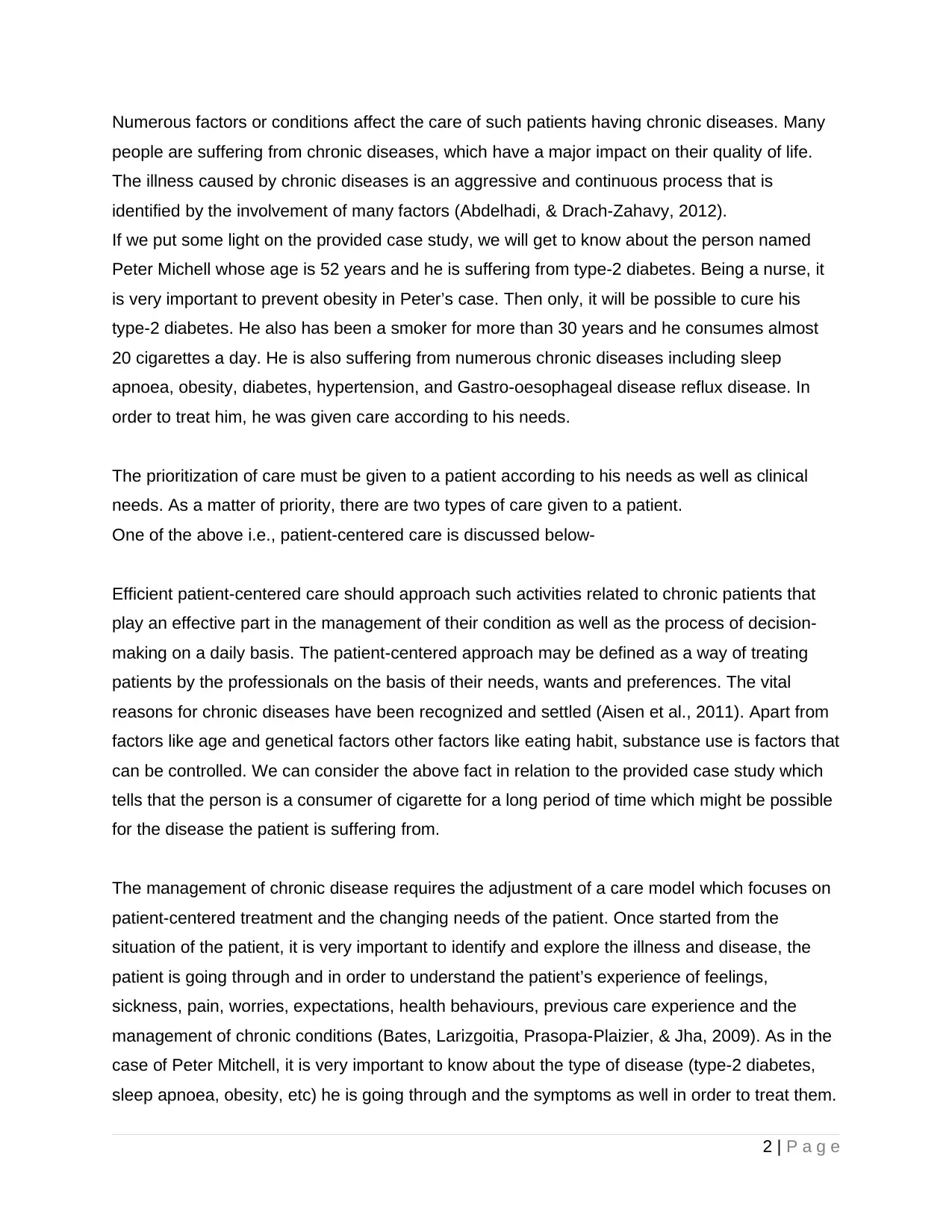
Numerous factors or conditions affect the care of such patients having chronic diseases. Many
people are suffering from chronic diseases, which have a major impact on their quality of life.
The illness caused by chronic diseases is an aggressive and continuous process that is
identified by the involvement of many factors (Abdelhadi, & Drach‐Zahavy, 2012).
If we put some light on the provided case study, we will get to know about the person named
Peter Michell whose age is 52 years and he is suffering from type-2 diabetes. Being a nurse, it
is very important to prevent obesity in Peter’s case. Then only, it will be possible to cure his
type-2 diabetes. He also has been a smoker for more than 30 years and he consumes almost
20 cigarettes a day. He is also suffering from numerous chronic diseases including sleep
apnoea, obesity, diabetes, hypertension, and Gastro-oesophageal disease reflux disease. In
order to treat him, he was given care according to his needs.
The prioritization of care must be given to a patient according to his needs as well as clinical
needs. As a matter of priority, there are two types of care given to a patient.
One of the above i.e., patient-centered care is discussed below-
Efficient patient-centered care should approach such activities related to chronic patients that
play an effective part in the management of their condition as well as the process of decision-
making on a daily basis. The patient-centered approach may be defined as a way of treating
patients by the professionals on the basis of their needs, wants and preferences. The vital
reasons for chronic diseases have been recognized and settled (Aisen et al., 2011). Apart from
factors like age and genetical factors other factors like eating habit, substance use is factors that
can be controlled. We can consider the above fact in relation to the provided case study which
tells that the person is a consumer of cigarette for a long period of time which might be possible
for the disease the patient is suffering from.
The management of chronic disease requires the adjustment of a care model which focuses on
patient-centered treatment and the changing needs of the patient. Once started from the
situation of the patient, it is very important to identify and explore the illness and disease, the
patient is going through and in order to understand the patient’s experience of feelings,
sickness, pain, worries, expectations, health behaviours, previous care experience and the
management of chronic conditions (Bates, Larizgoitia, Prasopa-Plaizier, & Jha, 2009). As in the
case of Peter Mitchell, it is very important to know about the type of disease (type-2 diabetes,
sleep apnoea, obesity, etc) he is going through and the symptoms as well in order to treat them.
2 | P a g e
people are suffering from chronic diseases, which have a major impact on their quality of life.
The illness caused by chronic diseases is an aggressive and continuous process that is
identified by the involvement of many factors (Abdelhadi, & Drach‐Zahavy, 2012).
If we put some light on the provided case study, we will get to know about the person named
Peter Michell whose age is 52 years and he is suffering from type-2 diabetes. Being a nurse, it
is very important to prevent obesity in Peter’s case. Then only, it will be possible to cure his
type-2 diabetes. He also has been a smoker for more than 30 years and he consumes almost
20 cigarettes a day. He is also suffering from numerous chronic diseases including sleep
apnoea, obesity, diabetes, hypertension, and Gastro-oesophageal disease reflux disease. In
order to treat him, he was given care according to his needs.
The prioritization of care must be given to a patient according to his needs as well as clinical
needs. As a matter of priority, there are two types of care given to a patient.
One of the above i.e., patient-centered care is discussed below-
Efficient patient-centered care should approach such activities related to chronic patients that
play an effective part in the management of their condition as well as the process of decision-
making on a daily basis. The patient-centered approach may be defined as a way of treating
patients by the professionals on the basis of their needs, wants and preferences. The vital
reasons for chronic diseases have been recognized and settled (Aisen et al., 2011). Apart from
factors like age and genetical factors other factors like eating habit, substance use is factors that
can be controlled. We can consider the above fact in relation to the provided case study which
tells that the person is a consumer of cigarette for a long period of time which might be possible
for the disease the patient is suffering from.
The management of chronic disease requires the adjustment of a care model which focuses on
patient-centered treatment and the changing needs of the patient. Once started from the
situation of the patient, it is very important to identify and explore the illness and disease, the
patient is going through and in order to understand the patient’s experience of feelings,
sickness, pain, worries, expectations, health behaviours, previous care experience and the
management of chronic conditions (Bates, Larizgoitia, Prasopa-Plaizier, & Jha, 2009). As in the
case of Peter Mitchell, it is very important to know about the type of disease (type-2 diabetes,
sleep apnoea, obesity, etc) he is going through and the symptoms as well in order to treat them.
2 | P a g e
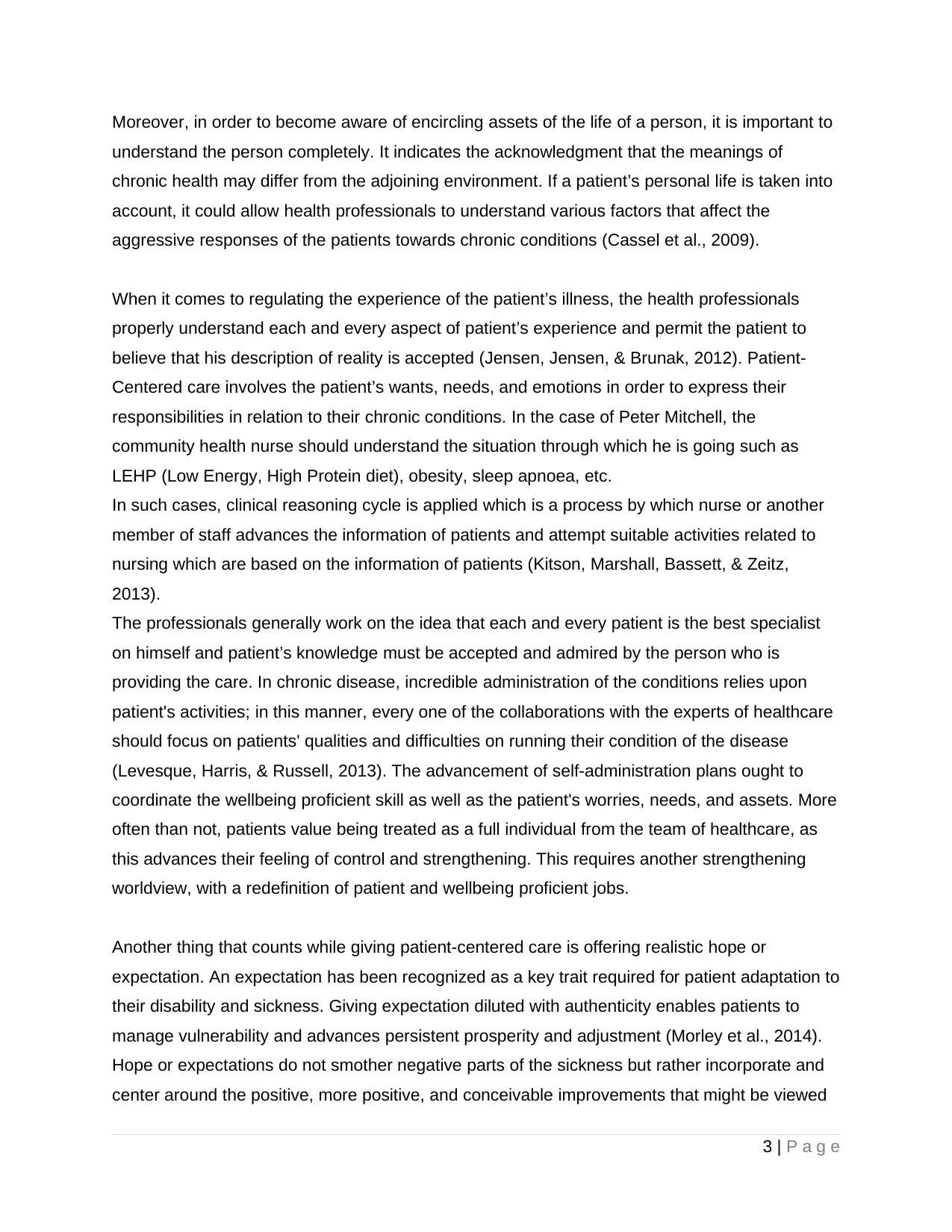
Moreover, in order to become aware of encircling assets of the life of a person, it is important to
understand the person completely. It indicates the acknowledgment that the meanings of
chronic health may differ from the adjoining environment. If a patient’s personal life is taken into
account, it could allow health professionals to understand various factors that affect the
aggressive responses of the patients towards chronic conditions (Cassel et al., 2009).
When it comes to regulating the experience of the patient’s illness, the health professionals
properly understand each and every aspect of patient’s experience and permit the patient to
believe that his description of reality is accepted (Jensen, Jensen, & Brunak, 2012). Patient-
Centered care involves the patient’s wants, needs, and emotions in order to express their
responsibilities in relation to their chronic conditions. In the case of Peter Mitchell, the
community health nurse should understand the situation through which he is going such as
LEHP (Low Energy, High Protein diet), obesity, sleep apnoea, etc.
In such cases, clinical reasoning cycle is applied which is a process by which nurse or another
member of staff advances the information of patients and attempt suitable activities related to
nursing which are based on the information of patients (Kitson, Marshall, Bassett, & Zeitz,
2013).
The professionals generally work on the idea that each and every patient is the best specialist
on himself and patient’s knowledge must be accepted and admired by the person who is
providing the care. In chronic disease, incredible administration of the conditions relies upon
patient's activities; in this manner, every one of the collaborations with the experts of healthcare
should focus on patients' qualities and difficulties on running their condition of the disease
(Levesque, Harris, & Russell, 2013). The advancement of self-administration plans ought to
coordinate the wellbeing proficient skill as well as the patient's worries, needs, and assets. More
often than not, patients value being treated as a full individual from the team of healthcare, as
this advances their feeling of control and strengthening. This requires another strengthening
worldview, with a redefinition of patient and wellbeing proficient jobs.
Another thing that counts while giving patient-centered care is offering realistic hope or
expectation. An expectation has been recognized as a key trait required for patient adaptation to
their disability and sickness. Giving expectation diluted with authenticity enables patients to
manage vulnerability and advances persistent prosperity and adjustment (Morley et al., 2014).
Hope or expectations do not smother negative parts of the sickness but rather incorporate and
center around the positive, more positive, and conceivable improvements that might be viewed
3 | P a g e
understand the person completely. It indicates the acknowledgment that the meanings of
chronic health may differ from the adjoining environment. If a patient’s personal life is taken into
account, it could allow health professionals to understand various factors that affect the
aggressive responses of the patients towards chronic conditions (Cassel et al., 2009).
When it comes to regulating the experience of the patient’s illness, the health professionals
properly understand each and every aspect of patient’s experience and permit the patient to
believe that his description of reality is accepted (Jensen, Jensen, & Brunak, 2012). Patient-
Centered care involves the patient’s wants, needs, and emotions in order to express their
responsibilities in relation to their chronic conditions. In the case of Peter Mitchell, the
community health nurse should understand the situation through which he is going such as
LEHP (Low Energy, High Protein diet), obesity, sleep apnoea, etc.
In such cases, clinical reasoning cycle is applied which is a process by which nurse or another
member of staff advances the information of patients and attempt suitable activities related to
nursing which are based on the information of patients (Kitson, Marshall, Bassett, & Zeitz,
2013).
The professionals generally work on the idea that each and every patient is the best specialist
on himself and patient’s knowledge must be accepted and admired by the person who is
providing the care. In chronic disease, incredible administration of the conditions relies upon
patient's activities; in this manner, every one of the collaborations with the experts of healthcare
should focus on patients' qualities and difficulties on running their condition of the disease
(Levesque, Harris, & Russell, 2013). The advancement of self-administration plans ought to
coordinate the wellbeing proficient skill as well as the patient's worries, needs, and assets. More
often than not, patients value being treated as a full individual from the team of healthcare, as
this advances their feeling of control and strengthening. This requires another strengthening
worldview, with a redefinition of patient and wellbeing proficient jobs.
Another thing that counts while giving patient-centered care is offering realistic hope or
expectation. An expectation has been recognized as a key trait required for patient adaptation to
their disability and sickness. Giving expectation diluted with authenticity enables patients to
manage vulnerability and advances persistent prosperity and adjustment (Morley et al., 2014).
Hope or expectations do not smother negative parts of the sickness but rather incorporate and
center around the positive, more positive, and conceivable improvements that might be viewed
3 | P a g e

as better results or better patient personal satisfaction. In the case study, Peter should be given
hope as well as some of the diet recommendations by his community nurse in order to treat him.
With respect to the clinical reasoning cycle of nursing, trust, mutual respect and understanding,
and cooperative activities are important factors in order to develop and improve the relationship
between a patient and a physician. The physician or the professional healthcare provider, as
well as the patient, need to understand the responsibility and sharing power. Moreover, they
must be committed to their role. In chronic disease, physical conditions of the patient, his
inclinations and limits change after some time and decide the idea of an organization at which
time (Ovretveit et al., 2013). Then again, congruity of consideration is a chance to improve the
relationship between the patient and the healthcare professional, to enable the patient and to
help amid the most troublesome periods of a chronic condition.
In Peter’s case, the community nurse should follow general patient-centered guidelines to cure
his type-2 diabetes and other issues. His diets and meals should be properly managed. No
snacking between the meals is recommended. In order to prevent snacking between meals, he
should be recommended to intake Avocados. Hydrogenated or partially hydrogenated products
must be avoided. Being a nurse, it is supposed to prevent Peter from eating three times a day
and those meals should be balanced properly. The community nurse should regularly monitor
his diet and the diets should be prepared by keeping his cultural and social background in the
mind. His priorities must be kept in mind as well. He should be recommended to cut down
sweets for some time. Physical exercises should be recommended in order to increase insulin
sensitivity. This is one of the priorities of patient-centered care that should be given to Peter to
control his obesity and cure his type-2 diabetes.
Another type of care which is known as clinical care i.e., the care which is provided to the
patients by looking at the basic needs and requirements of the clinic is discussed below-
The above type of care supports regulation and progression of care amid the providers. It also
includes an approach to, and the combination of, services provided by the specialists into this
provision of care (Pelzang, 2010). This type of care contributes towards the collective and
4 | P a g e
hope as well as some of the diet recommendations by his community nurse in order to treat him.
With respect to the clinical reasoning cycle of nursing, trust, mutual respect and understanding,
and cooperative activities are important factors in order to develop and improve the relationship
between a patient and a physician. The physician or the professional healthcare provider, as
well as the patient, need to understand the responsibility and sharing power. Moreover, they
must be committed to their role. In chronic disease, physical conditions of the patient, his
inclinations and limits change after some time and decide the idea of an organization at which
time (Ovretveit et al., 2013). Then again, congruity of consideration is a chance to improve the
relationship between the patient and the healthcare professional, to enable the patient and to
help amid the most troublesome periods of a chronic condition.
In Peter’s case, the community nurse should follow general patient-centered guidelines to cure
his type-2 diabetes and other issues. His diets and meals should be properly managed. No
snacking between the meals is recommended. In order to prevent snacking between meals, he
should be recommended to intake Avocados. Hydrogenated or partially hydrogenated products
must be avoided. Being a nurse, it is supposed to prevent Peter from eating three times a day
and those meals should be balanced properly. The community nurse should regularly monitor
his diet and the diets should be prepared by keeping his cultural and social background in the
mind. His priorities must be kept in mind as well. He should be recommended to cut down
sweets for some time. Physical exercises should be recommended in order to increase insulin
sensitivity. This is one of the priorities of patient-centered care that should be given to Peter to
control his obesity and cure his type-2 diabetes.
Another type of care which is known as clinical care i.e., the care which is provided to the
patients by looking at the basic needs and requirements of the clinic is discussed below-
The above type of care supports regulation and progression of care amid the providers. It also
includes an approach to, and the combination of, services provided by the specialists into this
provision of care (Pelzang, 2010). This type of care contributes towards the collective and
4 | P a g e
Secure Best Marks with AI Grader
Need help grading? Try our AI Grader for instant feedback on your assignments.
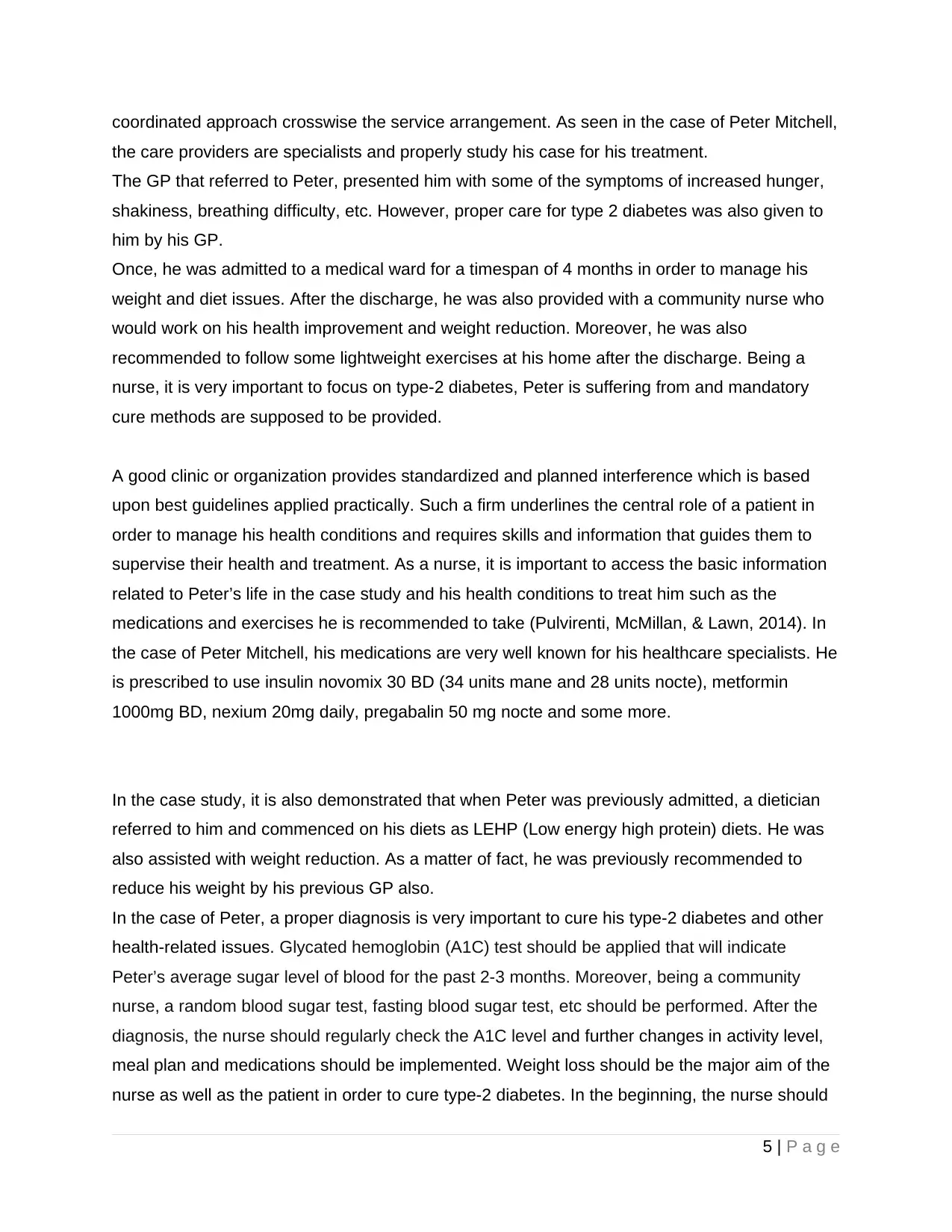
coordinated approach crosswise the service arrangement. As seen in the case of Peter Mitchell,
the care providers are specialists and properly study his case for his treatment.
The GP that referred to Peter, presented him with some of the symptoms of increased hunger,
shakiness, breathing difficulty, etc. However, proper care for type 2 diabetes was also given to
him by his GP.
Once, he was admitted to a medical ward for a timespan of 4 months in order to manage his
weight and diet issues. After the discharge, he was also provided with a community nurse who
would work on his health improvement and weight reduction. Moreover, he was also
recommended to follow some lightweight exercises at his home after the discharge. Being a
nurse, it is very important to focus on type-2 diabetes, Peter is suffering from and mandatory
cure methods are supposed to be provided.
A good clinic or organization provides standardized and planned interference which is based
upon best guidelines applied practically. Such a firm underlines the central role of a patient in
order to manage his health conditions and requires skills and information that guides them to
supervise their health and treatment. As a nurse, it is important to access the basic information
related to Peter’s life in the case study and his health conditions to treat him such as the
medications and exercises he is recommended to take (Pulvirenti, McMillan, & Lawn, 2014). In
the case of Peter Mitchell, his medications are very well known for his healthcare specialists. He
is prescribed to use insulin novomix 30 BD (34 units mane and 28 units nocte), metformin
1000mg BD, nexium 20mg daily, pregabalin 50 mg nocte and some more.
In the case study, it is also demonstrated that when Peter was previously admitted, a dietician
referred to him and commenced on his diets as LEHP (Low energy high protein) diets. He was
also assisted with weight reduction. As a matter of fact, he was previously recommended to
reduce his weight by his previous GP also.
In the case of Peter, a proper diagnosis is very important to cure his type-2 diabetes and other
health-related issues. Glycated hemoglobin (A1C) test should be applied that will indicate
Peter’s average sugar level of blood for the past 2-3 months. Moreover, being a community
nurse, a random blood sugar test, fasting blood sugar test, etc should be performed. After the
diagnosis, the nurse should regularly check the A1C level and further changes in activity level,
meal plan and medications should be implemented. Weight loss should be the major aim of the
nurse as well as the patient in order to cure type-2 diabetes. In the beginning, the nurse should
5 | P a g e
the care providers are specialists and properly study his case for his treatment.
The GP that referred to Peter, presented him with some of the symptoms of increased hunger,
shakiness, breathing difficulty, etc. However, proper care for type 2 diabetes was also given to
him by his GP.
Once, he was admitted to a medical ward for a timespan of 4 months in order to manage his
weight and diet issues. After the discharge, he was also provided with a community nurse who
would work on his health improvement and weight reduction. Moreover, he was also
recommended to follow some lightweight exercises at his home after the discharge. Being a
nurse, it is very important to focus on type-2 diabetes, Peter is suffering from and mandatory
cure methods are supposed to be provided.
A good clinic or organization provides standardized and planned interference which is based
upon best guidelines applied practically. Such a firm underlines the central role of a patient in
order to manage his health conditions and requires skills and information that guides them to
supervise their health and treatment. As a nurse, it is important to access the basic information
related to Peter’s life in the case study and his health conditions to treat him such as the
medications and exercises he is recommended to take (Pulvirenti, McMillan, & Lawn, 2014). In
the case of Peter Mitchell, his medications are very well known for his healthcare specialists. He
is prescribed to use insulin novomix 30 BD (34 units mane and 28 units nocte), metformin
1000mg BD, nexium 20mg daily, pregabalin 50 mg nocte and some more.
In the case study, it is also demonstrated that when Peter was previously admitted, a dietician
referred to him and commenced on his diets as LEHP (Low energy high protein) diets. He was
also assisted with weight reduction. As a matter of fact, he was previously recommended to
reduce his weight by his previous GP also.
In the case of Peter, a proper diagnosis is very important to cure his type-2 diabetes and other
health-related issues. Glycated hemoglobin (A1C) test should be applied that will indicate
Peter’s average sugar level of blood for the past 2-3 months. Moreover, being a community
nurse, a random blood sugar test, fasting blood sugar test, etc should be performed. After the
diagnosis, the nurse should regularly check the A1C level and further changes in activity level,
meal plan and medications should be implemented. Weight loss should be the major aim of the
nurse as well as the patient in order to cure type-2 diabetes. In the beginning, the nurse should
5 | P a g e
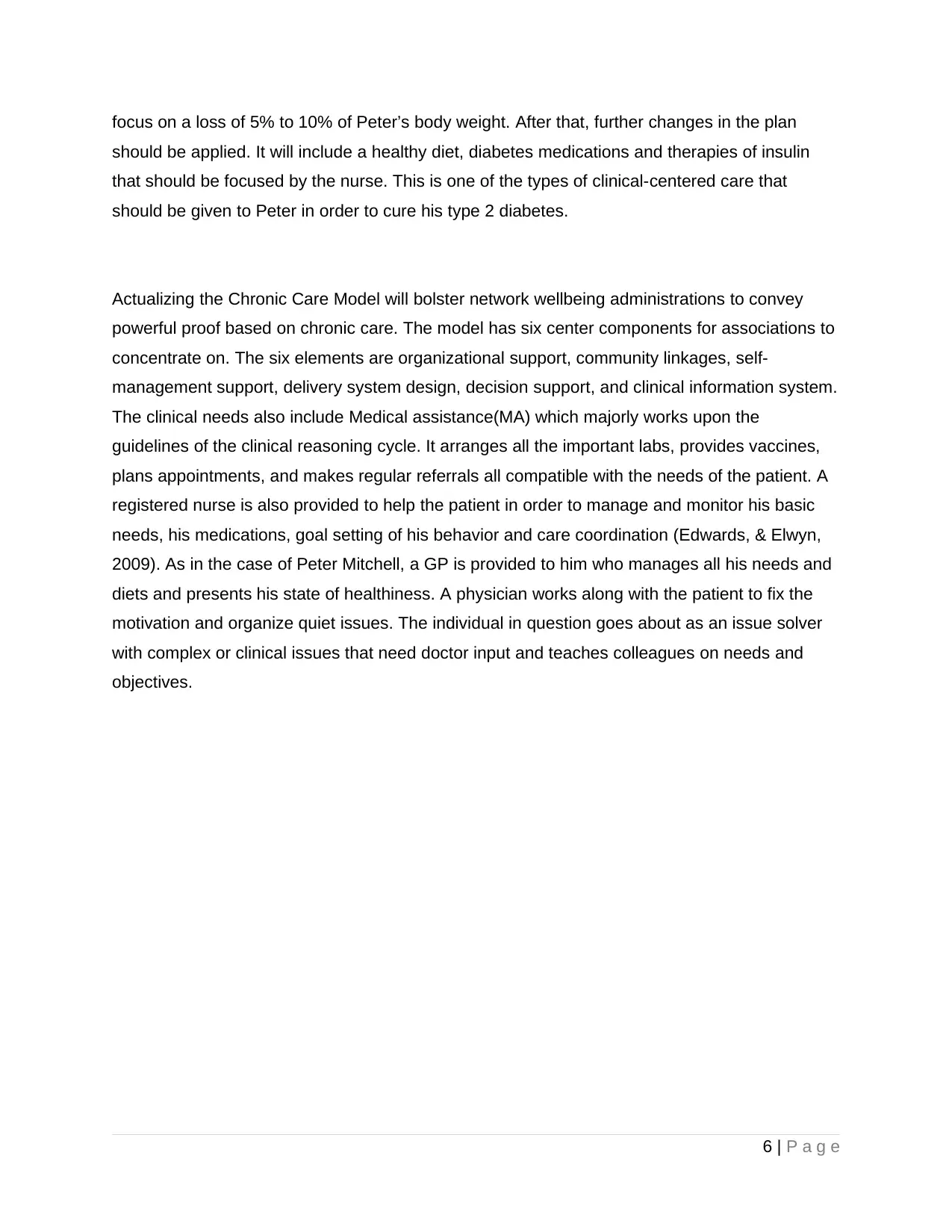
focus on a loss of 5% to 10% of Peter’s body weight. After that, further changes in the plan
should be applied. It will include a healthy diet, diabetes medications and therapies of insulin
that should be focused by the nurse. This is one of the types of clinical-centered care that
should be given to Peter in order to cure his type 2 diabetes.
Actualizing the Chronic Care Model will bolster network wellbeing administrations to convey
powerful proof based on chronic care. The model has six center components for associations to
concentrate on. The six elements are organizational support, community linkages, self-
management support, delivery system design, decision support, and clinical information system.
The clinical needs also include Medical assistance(MA) which majorly works upon the
guidelines of the clinical reasoning cycle. It arranges all the important labs, provides vaccines,
plans appointments, and makes regular referrals all compatible with the needs of the patient. A
registered nurse is also provided to help the patient in order to manage and monitor his basic
needs, his medications, goal setting of his behavior and care coordination (Edwards, & Elwyn,
2009). As in the case of Peter Mitchell, a GP is provided to him who manages all his needs and
diets and presents his state of healthiness. A physician works along with the patient to fix the
motivation and organize quiet issues. The individual in question goes about as an issue solver
with complex or clinical issues that need doctor input and teaches colleagues on needs and
objectives.
6 | P a g e
should be applied. It will include a healthy diet, diabetes medications and therapies of insulin
that should be focused by the nurse. This is one of the types of clinical-centered care that
should be given to Peter in order to cure his type 2 diabetes.
Actualizing the Chronic Care Model will bolster network wellbeing administrations to convey
powerful proof based on chronic care. The model has six center components for associations to
concentrate on. The six elements are organizational support, community linkages, self-
management support, delivery system design, decision support, and clinical information system.
The clinical needs also include Medical assistance(MA) which majorly works upon the
guidelines of the clinical reasoning cycle. It arranges all the important labs, provides vaccines,
plans appointments, and makes regular referrals all compatible with the needs of the patient. A
registered nurse is also provided to help the patient in order to manage and monitor his basic
needs, his medications, goal setting of his behavior and care coordination (Edwards, & Elwyn,
2009). As in the case of Peter Mitchell, a GP is provided to him who manages all his needs and
diets and presents his state of healthiness. A physician works along with the patient to fix the
motivation and organize quiet issues. The individual in question goes about as an issue solver
with complex or clinical issues that need doctor input and teaches colleagues on needs and
objectives.
6 | P a g e
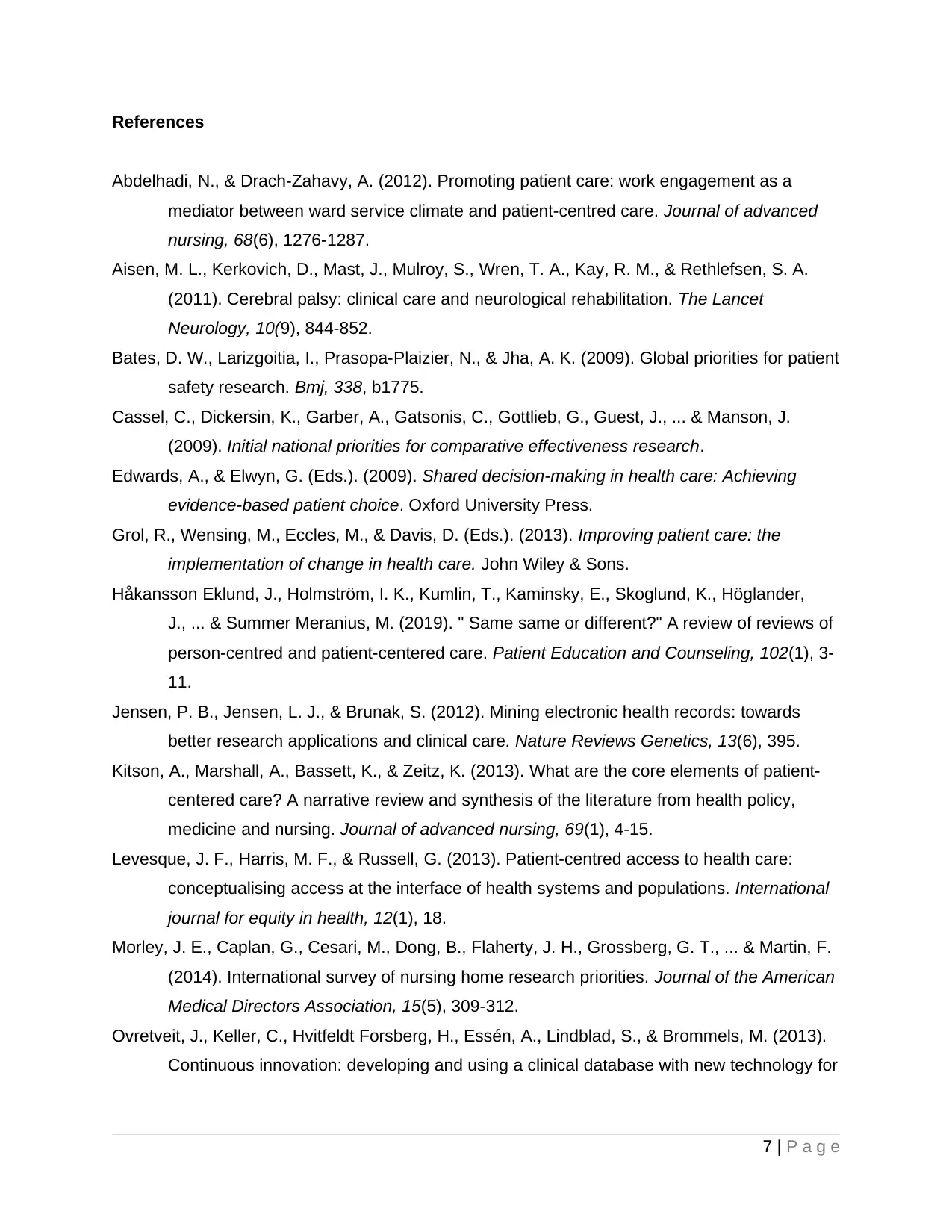
References
Abdelhadi, N., & Drach‐Zahavy, A. (2012). Promoting patient care: work engagement as a
mediator between ward service climate and patient‐centred care. Journal of advanced
nursing, 68(6), 1276-1287.
Aisen, M. L., Kerkovich, D., Mast, J., Mulroy, S., Wren, T. A., Kay, R. M., & Rethlefsen, S. A.
(2011). Cerebral palsy: clinical care and neurological rehabilitation. The Lancet
Neurology, 10(9), 844-852.
Bates, D. W., Larizgoitia, I., Prasopa-Plaizier, N., & Jha, A. K. (2009). Global priorities for patient
safety research. Bmj, 338, b1775.
Cassel, C., Dickersin, K., Garber, A., Gatsonis, C., Gottlieb, G., Guest, J., ... & Manson, J.
(2009). Initial national priorities for comparative effectiveness research.
Edwards, A., & Elwyn, G. (Eds.). (2009). Shared decision-making in health care: Achieving
evidence-based patient choice. Oxford University Press.
Grol, R., Wensing, M., Eccles, M., & Davis, D. (Eds.). (2013). Improving patient care: the
implementation of change in health care. John Wiley & Sons.
Håkansson Eklund, J., Holmström, I. K., Kumlin, T., Kaminsky, E., Skoglund, K., Höglander,
J., ... & Summer Meranius, M. (2019). " Same same or different?" A review of reviews of
person-centred and patient-centered care. Patient Education and Counseling, 102(1), 3-
11.
Jensen, P. B., Jensen, L. J., & Brunak, S. (2012). Mining electronic health records: towards
better research applications and clinical care. Nature Reviews Genetics, 13(6), 395.
Kitson, A., Marshall, A., Bassett, K., & Zeitz, K. (2013). What are the core elements of patient-
centered care? A narrative review and synthesis of the literature from health policy,
medicine and nursing. Journal of advanced nursing, 69(1), 4-15.
Levesque, J. F., Harris, M. F., & Russell, G. (2013). Patient-centred access to health care:
conceptualising access at the interface of health systems and populations. International
journal for equity in health, 12(1), 18.
Morley, J. E., Caplan, G., Cesari, M., Dong, B., Flaherty, J. H., Grossberg, G. T., ... & Martin, F.
(2014). International survey of nursing home research priorities. Journal of the American
Medical Directors Association, 15(5), 309-312.
Ovretveit, J., Keller, C., Hvitfeldt Forsberg, H., Essén, A., Lindblad, S., & Brommels, M. (2013).
Continuous innovation: developing and using a clinical database with new technology for
7 | P a g e
Abdelhadi, N., & Drach‐Zahavy, A. (2012). Promoting patient care: work engagement as a
mediator between ward service climate and patient‐centred care. Journal of advanced
nursing, 68(6), 1276-1287.
Aisen, M. L., Kerkovich, D., Mast, J., Mulroy, S., Wren, T. A., Kay, R. M., & Rethlefsen, S. A.
(2011). Cerebral palsy: clinical care and neurological rehabilitation. The Lancet
Neurology, 10(9), 844-852.
Bates, D. W., Larizgoitia, I., Prasopa-Plaizier, N., & Jha, A. K. (2009). Global priorities for patient
safety research. Bmj, 338, b1775.
Cassel, C., Dickersin, K., Garber, A., Gatsonis, C., Gottlieb, G., Guest, J., ... & Manson, J.
(2009). Initial national priorities for comparative effectiveness research.
Edwards, A., & Elwyn, G. (Eds.). (2009). Shared decision-making in health care: Achieving
evidence-based patient choice. Oxford University Press.
Grol, R., Wensing, M., Eccles, M., & Davis, D. (Eds.). (2013). Improving patient care: the
implementation of change in health care. John Wiley & Sons.
Håkansson Eklund, J., Holmström, I. K., Kumlin, T., Kaminsky, E., Skoglund, K., Höglander,
J., ... & Summer Meranius, M. (2019). " Same same or different?" A review of reviews of
person-centred and patient-centered care. Patient Education and Counseling, 102(1), 3-
11.
Jensen, P. B., Jensen, L. J., & Brunak, S. (2012). Mining electronic health records: towards
better research applications and clinical care. Nature Reviews Genetics, 13(6), 395.
Kitson, A., Marshall, A., Bassett, K., & Zeitz, K. (2013). What are the core elements of patient-
centered care? A narrative review and synthesis of the literature from health policy,
medicine and nursing. Journal of advanced nursing, 69(1), 4-15.
Levesque, J. F., Harris, M. F., & Russell, G. (2013). Patient-centred access to health care:
conceptualising access at the interface of health systems and populations. International
journal for equity in health, 12(1), 18.
Morley, J. E., Caplan, G., Cesari, M., Dong, B., Flaherty, J. H., Grossberg, G. T., ... & Martin, F.
(2014). International survey of nursing home research priorities. Journal of the American
Medical Directors Association, 15(5), 309-312.
Ovretveit, J., Keller, C., Hvitfeldt Forsberg, H., Essén, A., Lindblad, S., & Brommels, M. (2013).
Continuous innovation: developing and using a clinical database with new technology for
7 | P a g e
Paraphrase This Document
Need a fresh take? Get an instant paraphrase of this document with our AI Paraphraser

patient-centred care—the case of the Swedish quality register for arthritis. International
Journal for Quality in Health Care, 25(2), 118-124.
Pelzang, R. (2010). Time to learn: understanding patient-centred care. British journal of nursing,
19(14), 912-917.
Pulvirenti, M., McMillan, J., & Lawn, S. (2014). Empowerment, patient centred care and self-
management. Health Expectations, 17(3), 303-310.
8 | P a g e
Journal for Quality in Health Care, 25(2), 118-124.
Pelzang, R. (2010). Time to learn: understanding patient-centred care. British journal of nursing,
19(14), 912-917.
Pulvirenti, M., McMillan, J., & Lawn, S. (2014). Empowerment, patient centred care and self-
management. Health Expectations, 17(3), 303-310.
8 | P a g e
1 out of 8
Related Documents
Your All-in-One AI-Powered Toolkit for Academic Success.
+13062052269
info@desklib.com
Available 24*7 on WhatsApp / Email
![[object Object]](/_next/static/media/star-bottom.7253800d.svg)
Unlock your academic potential
© 2024 | Zucol Services PVT LTD | All rights reserved.





